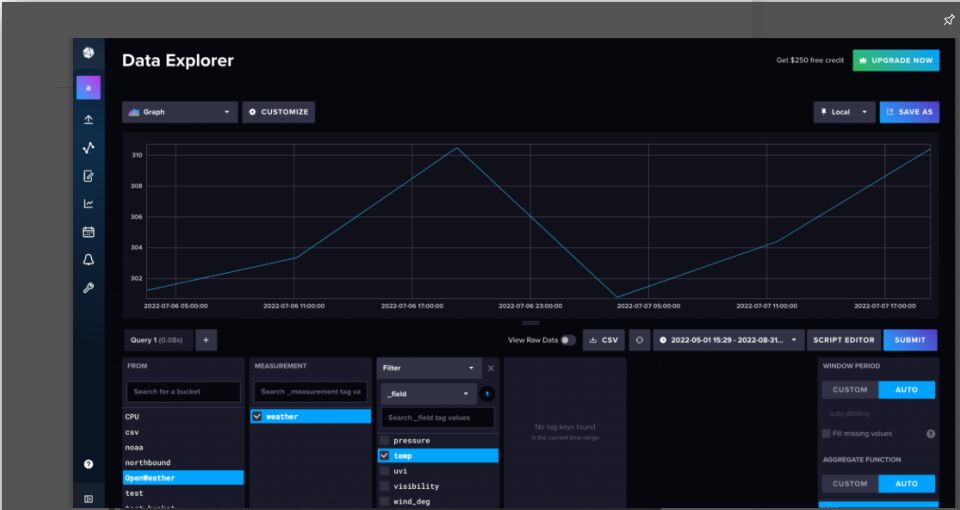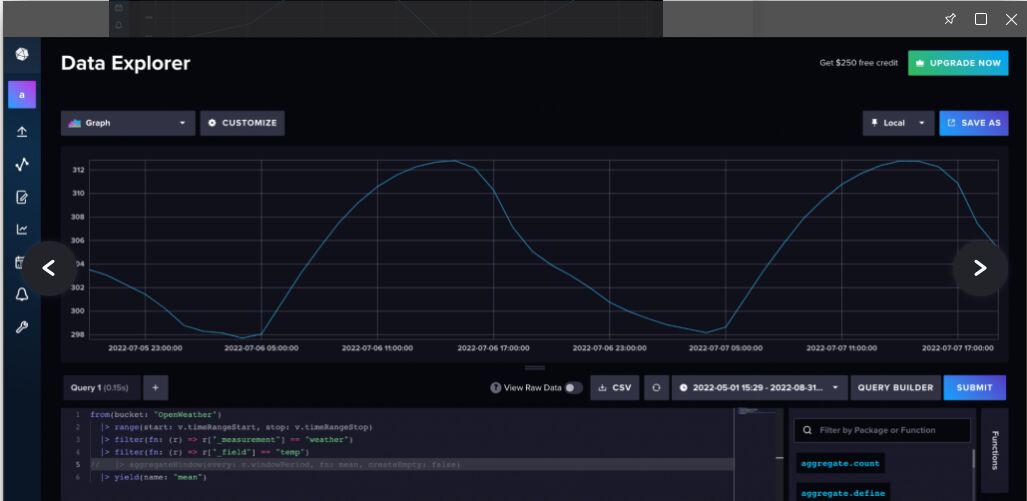使用Python采集和储存时间序列数据
来源:51CTO.COM
时间:2024-02-08 12:19:07 396浏览 收藏
各位小伙伴们,大家好呀!看看今天我又给各位带来了什么文章?本文标题是《使用Python采集和储存时间序列数据》,很明显是关于文章的文章哈哈哈,其中内容主要会涉及到等等,如果能帮到你,觉得很不错的话,欢迎各位多多点评和分享!

译者 | 布加迪
审校 | 孙淑娟
本教程将介绍如何使用Python从OpenWeatherMap API获取时间序列数据,并将其转换成Pandas DataFrame。接下来,我们将使用InfluxDB Python Client,将该数据写入到时间序列数据平台InfluxDB。
我们会将来自API调用的JSON响应转换成Pandas DataFrame,因为这是将数据写入到InfluxDB的最简单方法。由于InfluxDB是一个专门构建的数据库,我们写入到InfluxDB旨在满足时间序列数据在摄取方面的高要求。
要求
本教程在通过Homebrew已安装Python 3的macOS系统上完成。建议安装额外的工具,比如virtualenv、pyenv或conda-env,以简化Python和Client的安装。完整的要求在这里:
txt influxdb-client=1.30.0 pandas=1.4.3 requests>=2.27.1
本教程还假设您已经创建Free Tier InfluxDB云帐户或正在使用InfluxDB OSS,您也已经:
- 创建了存储桶。您可以将存储桶视为数据库或InfluxDB中最高层次的数据组织。
- 创建了令牌。
最后,该教程要求您已经使用OpenWeatherMap创建了一个帐户,并已创建了令牌。
请求天气数据
首先,我们需要请求数据。我们将使用请求库,通过OpenWeatherMap API从指定的经度和纬度返回每小时的天气数据。
# Get time series data from OpenWeatherMap API
params = {'lat':openWeatherMap_lat, 'lon':openWeatherMap_lon, 'exclude':
"minutely,daily", 'appid':openWeatherMap_token}
r = requests.get(openWeather_url, params = params).json()
hourly = r['hourly']将数据转换成Pandas DataFrame
接下来,将JSON数据转换成Pandas DataFrame。我们还将时间戳从秒精度的Unix时间戳转换成日期时间对象。之所以进行这种转换,是由于InfluxDB写入方法要求时间戳为日期时间对象格式。接下来,我们将使用这种方法,将数据写入到InfluxDB。我们还删除了不想写入到InfluxDB的列。
python # Convert data to Pandas DataFrame and convert timestamp to datetime object df = pd.json_normalize(hourly) df = df.drop(columns=['weather', 'pop']) df['dt'] = pd.to_datetime(df['dt'], unit='s') print(df.head)
将Pandas DataFrame写入到InfluxDB
现在为InfluxDB Python客户端库创建实例,并将DataFrame写入到InfluxDB。我们指定了测量名称。测量含有存储桶中的数据。您可以将其视为InfluxDB的数据组织中仅次于存储桶的第二高层次结构。
您还可以使用data_frame__tag_columns参数指定将哪些列转换成标签。
由于我们没有将任何列指定为标签,我们的所有列都将转换成InfluxDB中的字段。标签用于写入有关您的时间序列数据的元数据,可用于更有效地查询数据子集。字段是您在 InfluxDB中存储实际时间序列数据的位置。该文档(https://docs.influxdata.com/influxdb/cloud/reference/key-concepts/?utm_source=vendor&utm_medium=referral&utm_campaign=2022-07_spnsr-ctn_obtaining-storing-ts-pything_tns)更详细地介绍了InfluxDB中的这些数据概念。
on # Write data to InfluxDB with InfluxDBClient(url=url, token=token, org=org) as client: df = df client.write_api(write_options=SYNCHRONOUS).write(bucket=bucket,record=df, data_frame_measurement_name="weather", data_frame_timestamp_column="dt")
完整脚本
回顾一下,不妨看看完整的脚本。 我们采取以下步骤:
1. 导入库。
2. 收集以下内容:
- InfluxDB存储桶
- InfluxDB组织
- InfluxDB令牌
- InfluxDB URL
- OpenWeatherMap URL
- OpenWeatherMap 令牌
3. 创建请求。
4. 将JSON响应转换成Pandas DataFrame。
5. 删除您不想写入到InfluxDB的任何列。
6. 将时间戳列从Unix时间转换成Pandas日期时间对象。
7. 为InfluxDB Python Client库创建实例。
8. 编写DataFrame,并指定测量名称和时间戳列。
python
import requests
import influxdb_client
import pandas as pd
from influxdb_client import InfluxDBClient
from influxdb_client.client.write_api import SYNCHRONOUS
bucket = "OpenWeather"
org = "" # or email you used to create your Free Tier
InfluxDB Cloud account
token = "
url = "" # for example,
https://us-west-2-1.aws.cloud2.influxdata.com/
openWeatherMap_token = ""
openWeatherMap_lat = "33.44"
openWeatherMap_lon = "-94.04"
openWeather_url = "https://api.openweathermap.org/data/2.5/onecall"
# Get time series data from OpenWeatherMap API
params = {'lat':openWeatherMap_lat, 'lon':openWeatherMap_lon, 'exclude':
"minutely,daily", 'appid':openWeatherMap_token}
r = requests.get(openWeather_url, params = params).json()
hourly = r['hourly']
# Convert data to Pandas DataFrame and convert timestamp to datetime
object
df = pd.json_normalize(hourly)
df = df.drop(columns=['weather', 'pop'])
df['dt'] = pd.to_datetime(df['dt'], unit='s')
print(df.head)
# Write data to InfluxDB
with InfluxDBClient(url=url, token=token, org=org) as client:
df = df
client.write_api(write_options=SYNCHRONOUS).write(bucket=bucket,record=df,
data_frame_measurement_name="weather",
data_frame_timestamp_column="dt")查询数据
现在,我们已经将数据写入到InfluxDB,可以使用InfluxDB UI来查询数据了。导航到数据资源管理器(从左侧导航栏中)。使用Query Builder(查询构建器),选择想要可视化的数据和想要为之可视化的范围,然后点击“提交”。

图1. 天气数据的默认物化视图。InfluxDB自动聚合时间序列数据,这样新用户就不会意外查询太多数据而导致超时
专业提示:当您使用查询构建器查询数据时,InfluxDB自动对数据进行下采样。要查询原始数据,导航到Script Editor(脚本编辑器)以查看底层Flux查询。Flux是面向InfluxDB的原生查询和脚本语言,可用于使用您的时间序列数据来分析和创建预测。使用aggregateWindow()函数取消行注释或删除行,以查看原始数据。

图2. 导航到脚本编辑器,并取消注释或删除aggregateWindow()函数,以查看原始天气数据
结语
但愿本文能帮助您充分利用InfluxDB Python Client库,获取时间序列数据并存储到InfluxDB中。如果您想进一步了解使用Python Client库从InfluxDB查询数据,建议您看看这篇文章(https://thenewstack.io/getting-started-with-python-and-influxdb/)。另外值得一提的是,您可以使用Flux从OpenWeatherMap API获取数据,并将其存储到InfluxDB。如果您使用InfluxDB Cloud,这意味着该Flux脚本将被托管和定期执行,因此您可以获得可靠的天气数据流,并馈入到实例中。想进一步了解如何使用Flux按用户定义的时间表获取天气数据,请阅读这篇文章(https://www.influxdata.com/blog/tldr-influxdb-tech-tips-handling-json-objects-mapping-arrays/?utm_source=vendor&utm_medium=referral&utm_campaign=2022-07_spnsr-ctn_obtaining-storing-ts-pything_tns)。
以上就是《使用Python采集和储存时间序列数据》的详细内容,更多关于Python,时间序列数据的资料请关注golang学习网公众号!
-
501 收藏
-
501 收藏
-
501 收藏
-
501 收藏
-
501 收藏
-
283 收藏
-
349 收藏
-
291 收藏
-
204 收藏
-
401 收藏
-
227 收藏
-
400 收藏
-
327 收藏
-
124 收藏
-
450 收藏
-
347 收藏
-
464 收藏
-

- 前端进阶之JavaScript设计模式
- 设计模式是开发人员在软件开发过程中面临一般问题时的解决方案,代表了最佳的实践。本课程的主打内容包括JS常见设计模式以及具体应用场景,打造一站式知识长龙服务,适合有JS基础的同学学习。
- 立即学习 543次学习
-

- GO语言核心编程课程
- 本课程采用真实案例,全面具体可落地,从理论到实践,一步一步将GO核心编程技术、编程思想、底层实现融会贯通,使学习者贴近时代脉搏,做IT互联网时代的弄潮儿。
- 立即学习 516次学习
-

- 简单聊聊mysql8与网络通信
- 如有问题加微信:Le-studyg;在课程中,我们将首先介绍MySQL8的新特性,包括性能优化、安全增强、新数据类型等,帮助学生快速熟悉MySQL8的最新功能。接着,我们将深入解析MySQL的网络通信机制,包括协议、连接管理、数据传输等,让
- 立即学习 500次学习
-

- JavaScript正则表达式基础与实战
- 在任何一门编程语言中,正则表达式,都是一项重要的知识,它提供了高效的字符串匹配与捕获机制,可以极大的简化程序设计。
- 立即学习 487次学习
-

- 从零制作响应式网站—Grid布局
- 本系列教程将展示从零制作一个假想的网络科技公司官网,分为导航,轮播,关于我们,成功案例,服务流程,团队介绍,数据部分,公司动态,底部信息等内容区块。网站整体采用CSSGrid布局,支持响应式,有流畅过渡和展现动画。
- 立即学习 485次学习
